A New Decade of Megachurches
2011 Profile of Large Attendance Churches in the United States
by Warren Bird and Scott Thumma
Download a copy in PDF format for easier reading and printing.
Overview
The latest national survey of megachurches from Leadership Network and Hartford Institute for Religion Research reveals interesting dynamics related to growth, vitality and leadership. This fourth survey in a decade shows that megachurches remain one of the most robust religious organizational expressions within North America. This present report describes the overall results of the 2011 study of 336 megachurches (out of 1,611 or a 21% response rate).
Executive Summary
Last weekend, about 56 million Americans worshipped at a Protestant church. Most of those churches drew fewer than 100 people each, a size that’s characterized the “typical” church for centuries. But in the last few decades a new class of church has emerged: the very large church, often called a megachurch. And last weekend over 10% – or nearly 6 million – of these worshippers were part of congregations that each drew 2,000 or more in total attendance. If this group of churches were a Protestant denomination, it would be the nation’s second largest such group.
In recent months we surveyed this group of very large churches and made some fascinating discoveries. The following list highlights some of the most important findings. We will also be releasing more of findings from this survey in the coming months.
•
These churches are wired.
While 88% say their church/pastoral leadership uses Facebook or other social media on a regular basis, nearly three-fourths do podcasts and 56% blog.
•
Multisite interest has grown dramatically.
Half are multisite with another 20% thinking about it.
•
Growth is steady.
Despite occasional news reports that large churches are a Boomer phenomenon or are now in decline, a steady growth pattern remains evident, with these churches averaging 8% growth per year for last five years. Thus the stated average attendance for these churches grew from 2,604 in 2005 to 3,597 in 2010.
•
The leader at the helm makes all the difference.
Seventy-nine percent say the church’s most dramatic growth occurred during tenure of current senior pastor.
•
Worship options extend beyond Sunday morning.
While virtually all have multiple Sunday morning services, 48% have one or more Saturday night services, and 41% have one or more Sunday night services.
•
They are both big and small.
Eighty-two percent say small groups are “central to our strategy of Christian nurture and spiritual formation,” and 72% put a “lot of emphasis” on “Scripture studies other than Sunday school.” They report that 46% of their attenders are involved in small groups.
•
They have a high view of their own spiritual vitality.
An overwhelming 98% agree that their congregations are “spiritually alive and vital.” In addition, 98% say they have strong beliefs and values, 95% say they have a clear mission, and 93% say they are willing to change to meet new challenges.
•
Newcomer orientation is constant.
Forty percent of regular participants age 18 and older are new to the congregation in the last five years. And 70% of participants are under the age of 50.
•
The dominant identity is “evangelical.”
Of eight options offered, the majority chose the word evangelical to identify their theological outlook. Interestingly, barely 1% chose labels at the two theological extremes – either fundamentalist or liberal.
•
The vast majority do not have serious financial struggles.
Only 6% say church’s financial health is in some or serious difficulty (and only 7% said that for five years previously). However, half adversely felt the effects of the economic crisis and 5% fewer report their financial health as “excellent” compared to five years ago.
•
Staffing costs are comparable to those of other churches.
Forty-eight percent of the average large church’s total expenditures go to salary and benefits.
•
They are not independent.
Seventy percent say their church is part of a denomination, network, fellowship, or association of churches. For those who are currently non-denominational, 33% say they were once part of a denomination.
Distinguishing Features
Obviously their large size distinguishes megachurches from other congregations. Our study included Protestant congregations with an average weekly attendance of 1,800 or larger for all services and campuses combined (adults and children included) during the early months of 2011. While 2,000 attendees is the typical cutoff for a megachurch designation, these congregations fluctuate enough that the lower number group has been included. The survey is of 336 churches 1,800 and up, with 304 respondents represented churches having attendance of 2,000 or more.
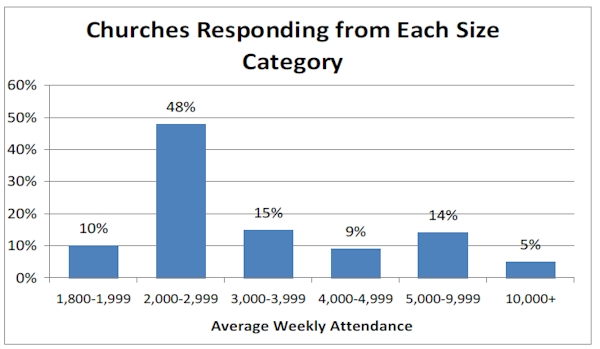
The average attendance of these congregations in 2011 is 3,924 but nearly half of the megachurches surveyed fall in the 2,000 to 3,000 range. The largest church in the survey reported weekly attendance of 22,500. While these congregations may be considerably larger than the average church, megachurches too suffer from having considerably more people associated with the church than regularly participate or attend weekly. The median number of people associated in any way with the church was 5,000, whereas the median regular participants figure was 3,222 and weekly attendance median is 2,750.
While megachurches have very large attendance figures, they often do not have massive sanctuaries. The average seating capacity of the largest sanctuary a church has was 1,778, with a median of 1,500. As in our previous surveys, it is apparent that megachurches make excellent use of multiple services to increase their capacity, and many also are multisite (one church in two or more locations). While virtually all have multiple Sunday morning services, 48% have one or more Saturday night services, and 41% have one or more Sunday night services. Megachurches held on average 5.5 services from Friday through Sunday.
Even given the multiple services and locations, many megachurches bemoan the fact that they have slightly less or much less space than they need for the regular functioning of their church.
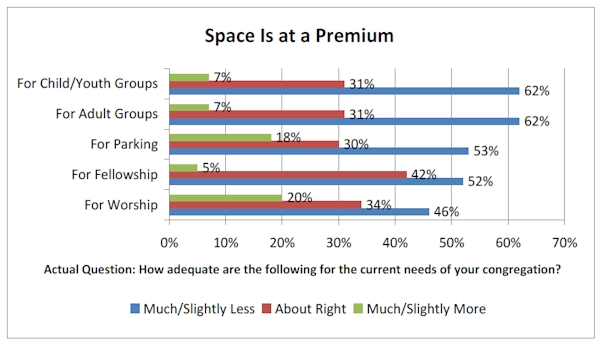
Multisite Expansion
Additionally, 46% of churches reported holding services at multiple locations, with another 20% of them saying they were considering this strategy. This finding is evidence of the steady growth of the multisite phenomenon seen in our previous studies. For those churches with satellite campuses, they average 2.6 locations in addition to the main campus. Multisite megachurches are growing faster (95% growth rate) than single site ones (70%) over the past five years; however, those churches “thinking about” becoming multisite in fact have the fastest average growth rate (133%).
Additionally, the larger the church, the more likely it is to have multiple campuses. So the multisite megachurches have significantly larger median attendance, by almost 1,500 people, but their total seating of the largest sanctuary is no bigger than those with a single location – median of about 1,730. If these findings are controlled based on size, then multisite churches have significantly smaller sanctuaries comparatively. Perhaps this is one of the key motivational reasons for adopting a multisite approach.
While megachurches can be found throughout the country, they remain concentrated in certain regions, with the southern and far west regions dominating.
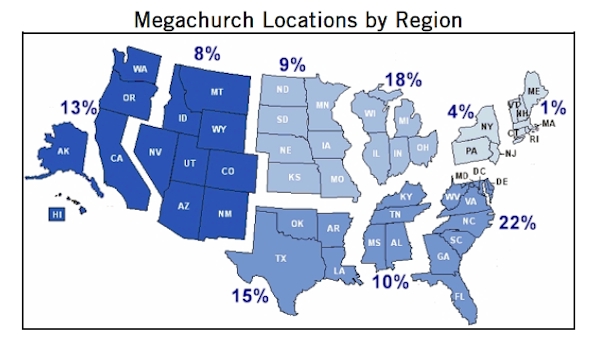
In terms of religious affiliation, a large percentage (54%) of megachurches are nondenominational. This figure is dramatically higher than we found in previous studies, where roughly a third were not affiliated with a denomination. Perhaps the intentional migration out of denominations underlies this shift, since 33% of the current nondenominational churches said they were once part of a denomination. At the same time, these megachurches are not completely unaffiliated, with 70% saying they have some connection to a network, fellowship, association or denomination.
Whether a denominational affiliate or not, the vast majority of the sample (71%) described the theological outlook of the membership as evangelical. Interestingly, barely 1% chose labels at the two theological extremes – either fundamentalist or liberal.

Racially, megachurches are predominantly white, with 82% having a majority of Caucasian participants. Megachurches are underrepresented among other racial groups compared to national race distributions, but this does seem to be changing gradually. Interestingly, the race of the senior leader varied somewhat from the majority race of the churches surveyed. Four percent of megachurches in the study reported having no racial majority in the church.

Although the impression is that these very large churches appeared on the horizon recently, the founding dates of such churches is scattered throughout the 20th century.
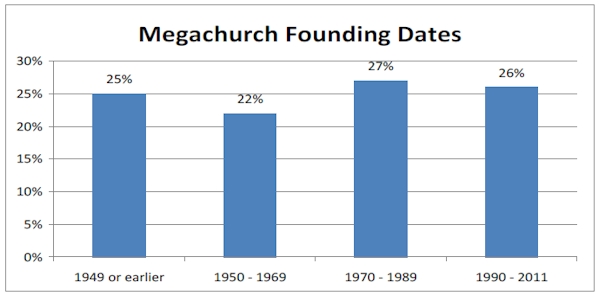
Megachurch Growth
Contrary to a number of recent news reports and blog posts, very large churches continue to show an overall pattern of continued dramatic growth. The surveyed megachurches reported a median growth rate of 47% between 2005 and 2011 or an average of 8% a year. This expansion is not shared uniformly across all respondent congregations. In fact, 15% did not grow at all or were in decline over the past half-decade, while 28% grew by 100% or more.
Who Are Their Participants?
People attracted to the average megachurch are youthful, family oriented and solidly middle class. The average age range is in the 30s to 40s and a full 70% are under the age of 50. This means that megachurches are not just filled with adults but with vast numbers of children and teens as well.
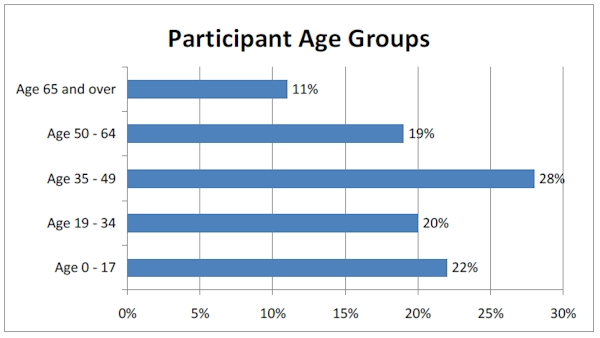
Like nearly every church of any size, there are more women than men in the megachurch, but unlike most churches the balance between genders is closer to even (55% women to 45% men). Just over half of participants have college degrees (52%). And although most megachurches have a regional draw, 60% of attenders live within 15 minutes of their church.
Newcomer orientation is constant within these very large congregations. With 40% of adult regular participants being new to the congregation in the last five years, much energy within the ministry is spent on integration, discipleship and volunteer development. At the same time, only 20% are identified as life-long members of the congregation. Yet even with this large percentage of more recently arrived participants, nearly two-thirds (61%) of these churches say their active participants are involved “a lot” or “quite a bit” in recruiting new people. Additionally only 13% of megachurches claim to have the same people serving over and over in volunteer leadership roles.
Megachurch Worship, Small Groups and Overall Character
There is no denying that megachurch worship is dynamic and powerful with thousands of people, contemporary music and high tech electronics. How much the contemporary worship contributes to the success of megachurches is unknown – although it does have a strong correlation to member growth in congregations of all sizes – but it is clearly present always or often in these churches as the graphic shows.
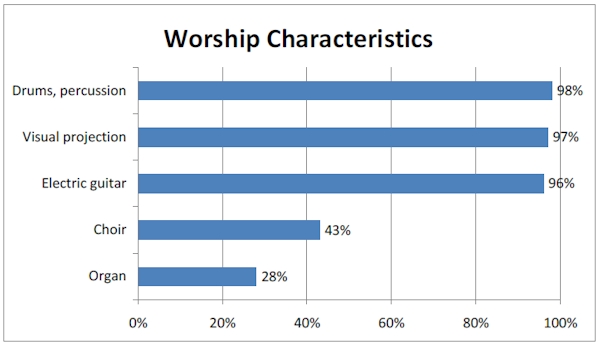
The atmosphere and ethos of megachurches is one of optimism, vitality and purpose. Whether these attributes came before or following their tremendous growth is uncertain but their spiritual confidence makes them attractive to those involved. Well over half of megachurch leaders strongly agree that their congregations hold strong beliefs and values, have a clear mission and purpose, are spiritually vital and alive, and are willing to change to meet new challenges. These perceptions are more than twice the scores of evangelical churches of all sizes in a comparable survey.
The combination of professional, lively contemporary worship and an optimistic spiritual vitality create an atmosphere of robust worship for many attendees and leadership. Megachurch services are described by the church leaders in distinctive ways.
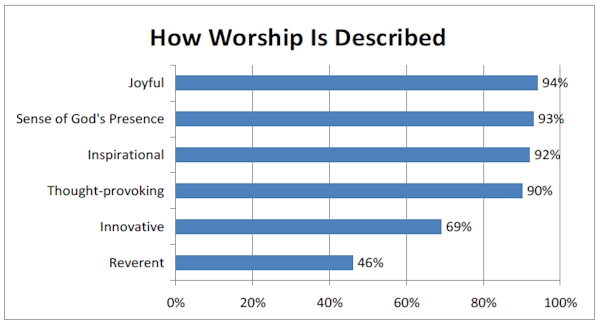
Further, these congregations have embraced the latest technologies. Such high-tech adoptions are even more powerful signals to younger adults that these congregations are relevant and in touch with contemporary reality. All these congregations use email and websites. Likewise, 88% say the church/pastoral leadership uses Facebook or other social media on a regular basis, nearly three-fourths do podcasts, 56% blog and over a third use other Internet technologies such as streaming, Twitter, texting and online church services. Additionally, only 2% say they never use visual projection equipment in worship whereas 96% say they always do.
Contrary to popular perceptions these churches emphasize personal accountability and Christian spiritual practices among attenders. At least three-quarters of megachurches claim to promote “quite a bit” or “a lot” the practices of prayer, Bible study, educating the children in faith and stressing premarital sexual chastity.
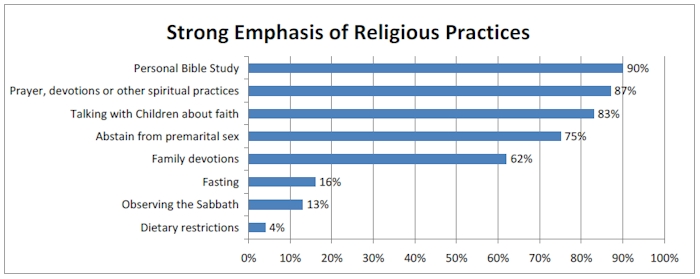
This emphasis on Christian practices is reinforced by the countless programs available at most megachurches. A large percentage of them describe the following programs or activities as being given “a lot of emphasis” or “a specialty of the church”. Notice that voter education and registration only garners programmatic support from a third of the megachurches.

Judging from responses in the above graphic, community service activities--an engagement with the larger needs of the community—is increasingly central to megachurch programmatic efforts. This can clearly be seen in the large percentage of these churches providing services directed at members and a larger constituency. Over 50% of megachurches engaged in the following eight service efforts alone or together with other groups.

Not only do these congregations work hard at providing ministry and mission efforts for participants but they have, in a sense, manufactured spaces for intimacy. These very large congregations work hard at being as small as possible for attendees. Eighty-two percent of megachurches say small groups are “central to our strategy of Christian nurture and spiritual formation.” Additionally, they report on average that nearly half (46%) of members are involved in small groups. As a result, 61% of the churches agree or strongly agree that their congregation is like a close-knit family.
A Leadership Profile
In part this intimacy is the result of programmatic design, and in part it is through the efforts of the leadership. In many ways the leader of the megachurch makes a significant difference. They are the visionary leader and set the tone, create much of the focus of the congregation.
Not surprisingly, almost 8 out of 10 megachurches still are under the leadership of the senior pastor under whose tenure the most dramatic growth occurred. These clergy are on average 51 years old, male and have masters or doctoral degrees, which is slightly younger and better educated than smaller church counterparts. Half of them have become the senior leader since 1997. And while their extended family might worship at the church (70%) and some work there (41%), few of these leaders inherited the position from a relative (only 5%).
These clergy are supported by, on average, 11 full-time and 4 part-time ordained clergy professionals. Additionally, they have on average 33 full-time and 27 part-time administrative, program and other support staff. However, in total these congregations roughly spend the same percentage of their budgets on staff (45%) as do smaller churches.

The Impact of the Great Recession
Considerable adverse press has emphasized the negative impact of the recession on megachurches. Yet, the vast majority of these churches report that they do not have serious financial struggles. Only 6% say church’s financial health is in some or serious difficulty (and only 7% said that for five years previously). However, half say they felt the effects of the economic crisis adversely and presently 5% fewer churches report their financial health as excellent compared to 5 years ago. In all, different megachurches were affected by the recession in a variety of ways, much like the entire country. Some were hurt considerably while others flourished.

Nevertheless, as will be addressed in a later report, nearly all the megachurch felt the recession as a result of an increase in individual needs. This was evident in the program emphasis on job training and financial counseling. Likewise requests for help increased to differing degrees for nearly all megachurches in terms of cash assistance, counseling, emergency housing and unemployment support of the membership. Even given these facts, the scenario was not as sober as sometimes portrayed.
Future Reports
This report offers an updated initial overview of the megachurch phenomenon as it enters a new decade. In many ways the dynamics within very large churches remains consistent with our previous research. They are neither in dire shape nor a bubble that is about to burst. They remain a vibrant, growing and highly influential segment of American religious life. Subsequent research reports available throughout the coming months will explore the dynamics of these churches in much greater detail and reflect on the ten years of findings about megachurches from our two organizations.
Watch for these later reports addressing:
•
The most dramatic changes that have taken place over the past 10 years of megachurch research,
•
How megachurches fared in the Great Recession,
•
Comparisons between very large Protestant and Catholic churches,
•
The unique features of megachurches compared to smaller congregations, and
•
The distinctive patterns among predominantly white, African American and multiracial megachurches.
About the Authors
 Warren Bird, Ph.D., is the Research Director at Leadership Network, and co-author of 23 books for church leaders www.leadnet.org/warrenbird Warren Bird, Ph.D., is the Research Director at Leadership Network, and co-author of 23 books for church leaders www.leadnet.org/warrenbird
 Scott Thumma, Ph.D., is professor of sociology at Hartford Seminary, a principal researcher for the related Hartford Institute for Religion Research, and co-author of Beyond Megachurch Myths. Scott Thumma, Ph.D., is professor of sociology at Hartford Seminary, a principal researcher for the related Hartford Institute for Religion Research, and co-author of Beyond Megachurch Myths.
Scott and Warren together authored The Other 80 Percent: Turning Your Church’s Spectators into Active Participants (Jossey-Bass, 2011).
The survey was part of the Faith Communities Today initiative,where various faith groups each survey their constituency then collectively create a larger national sample of religious congregations. The megachurch portion of Faith Communities Today, represented by this survey, was administered jointly by the Hartford Institute for Religion Research, where Scott Thumma is a primary researcher, and Leadership Network, where Warren Bird is research director. The survey was fielded by mail and email during February to April 2011, asking a key informant about 141 different data points. Of 1,611 churches contacted, 336 responded or 21%. The responses were weighted by denomination and geography against the known universe of North American megachurches.
Leadership Network…
•
explores the “what’s next?” of what could be.
•
creates “aha!” environments for collaborative discovery.
•
works with exceptional “positive deviants.”
•
invests in the success of others through generous relationships.
•
pursues big impact through measurable kingdom results.
•
strives to model Jesus through all we do.
Believing that meaningful conversations and strategic connections can change the world, we seek to help leaders navigate the future by exploring new ideas and finding application for each unique context. Through collaborative meetings and processes, leaders map future possibilities and challenge one another to action that accelerates fruitfulness and effectiveness. Leadership Network shares the learnings and inspiration with others through our books, concept papers, research reports, e-newsletters, podcasts, videos, and online experiences. This in turn generates a ripple effect of new conversations and further influence.
Additional Resources
Want to find more resources like this one? For the most current listing of free and purchasable resources, including books, papers, videos and podcasts, go to leadnet.org/resources. Leadership Network Advance E-newsletter: our free, indispensable, twice-monthly email newsletter featuring the best in innovative church strategies, including news of upcoming Leadership Network events.
Further Reading
For full survey results of this and several megachurch research projects, go to www.hartfordinstitute.org/megachurch/megachurches_research.html.
For other reports our two organizations have co-authored visit our resources at Leadership Network www.leadnet.org/megachurch or Hartford Institute for Religion Research www.hartfordinstitute.org/megachurch/megachurches.html
This report was released on November 22, 2011. Copyright 2011 by Leadership Network and Hartford Seminary. We encourage you to use and share this material freely—but please don’t charge money for it, change the wording, or remove the copyright information.
If you have questions, please direct them to:
Scott Thumma
Hartford Institute for Religion Research
Hartford Seminary
77 Sherman Street
Hartford, CT 06105
sthumma@hartsem.edu |
Warren Bird
Leadership Network
2626 Cole Ave., Suite 900
Dallas, TX 75204
warren.bird@leadnet.org |
|
